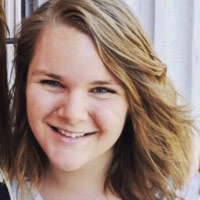Sara Stephens
Class of 2011, BFA in Creative Writing, Minors in History and Theological studies

What was your favorite part of studying Creative Writing at UE?
In my writing classes, the professors got both broad and specific with their advice. Rather than workshops asking me to "work on" various aspects, I got actual, tactile feedback I could apply to the piece right away. For example, instead of hearing "this rhyme sounds forced," I heard, "when rhyming a common word with an uncommon one, use the uncommon word first." They matched that specificity with big picture items like how to get published, and practical life as a writer was always part of the conversation.
What did you experience in UE's CRW department that feels special/unique to our program?
I loved the balance between writing and literature courses. Instead of slamming writing students with workshop after workshop for four years, which can get kind of incestuous and repetitive, the CRW department eased us in with intro courses that were part workshop, part craft lecture, part literature analysis, and we took tons of lit courses to study the old and new greats. As a writing major, I took both American lit surveys, both British lit surveys, Shakespeare (in England at Harlaxton!), world classics, and a special topics course on William Faulkner. Having such a wealth of exposure to people who have written well across the centuries helped me aim high with my own writing. Bonus: I graduated six years ago, and my professors are still in touch and actively helping me succeed with recommendation letters, guidance, wisdom, and Facebook likes. I value the CRW faculty's counsel so highly that, the summer after my second year in grad school, I spent all my money to go to the Harlaxton Summer Writing Program so they could help me write my master's thesis.
What was your favorite Creative Writing class and why?
It's a tie between Margaret McMullan's introduction to creative nonfiction and Rob Griffith's senior seminar class, genre fiction as literature. In intro to CNF, I learned about a whole field of writing that I didn't know had a name, and the structure of reading from the Touchstone Anthology and identifying elements to include in our own work gave me the courage to experiment in a form I'd never tried before. Best of all, Prof. McMullan trusted me when I proposed a love story about the human liver for my final project and encouraged me to write it boldly and honestly. In senior sem, all the English majors got to question the assumption that genre fiction "doesn't count as real literature," and we saw how several writers in genre drew on their literary forebears in their work. As a bonus, Prof. Griffith assigned the science fiction novel Hyperion--modeled on Chaucer's Canterbury Tales--which remains in my top ten books of all time.
What are you up to now?
I got my MFA in poetry at Georgia College & State University in Flannery O'Conner's hometown and got to study under Alice Friman. After teaching high school English in Nashville for three years after that, I just started the (fully funded) PhD program in English at the University of Mississippi, where I'm studying Southern literature.
My poem sequence "Parables with Eighth Graders" was published in print by Relief Journal. "Archery" was published by Prick of the Spindle. Deep South Magazine published my poem "Salt," which was nominated for a Pushcart Prize. I have been working for a long time on a piece about that thing where bugs fly into your porch lights. It's called "Phototaxis."
Office Phone
812-488-2963
Office Email
ML281@evansville.edu
Office Location
Room 329, Olmsted Administration Hall
